Healthcare Communication: An Annotated Bibliography of Key Articles
VerifiedAdded on 2023/06/12
|7
|1571
|80
Annotated Bibliography
AI Summary
This annotated bibliography compiles and summarizes five articles focusing on effective communication in various healthcare settings. The first article identifies communication barriers in surgical ICUs from the perspective of nurses. The second evaluates the impact of a simulation-based training program on communication in emergency departments. The third discusses the evolving role of technology in doctor-patient communication. The fourth examines care coordination programs for children with special healthcare needs, highlighting the importance of communication between families and providers. Finally, the fifth explores the therapeutic relationship between nurses and patients in psychiatric wards, focusing on the barriers to effective communication. Each annotation provides a summary of the article's purpose, methodology, findings, and limitations.
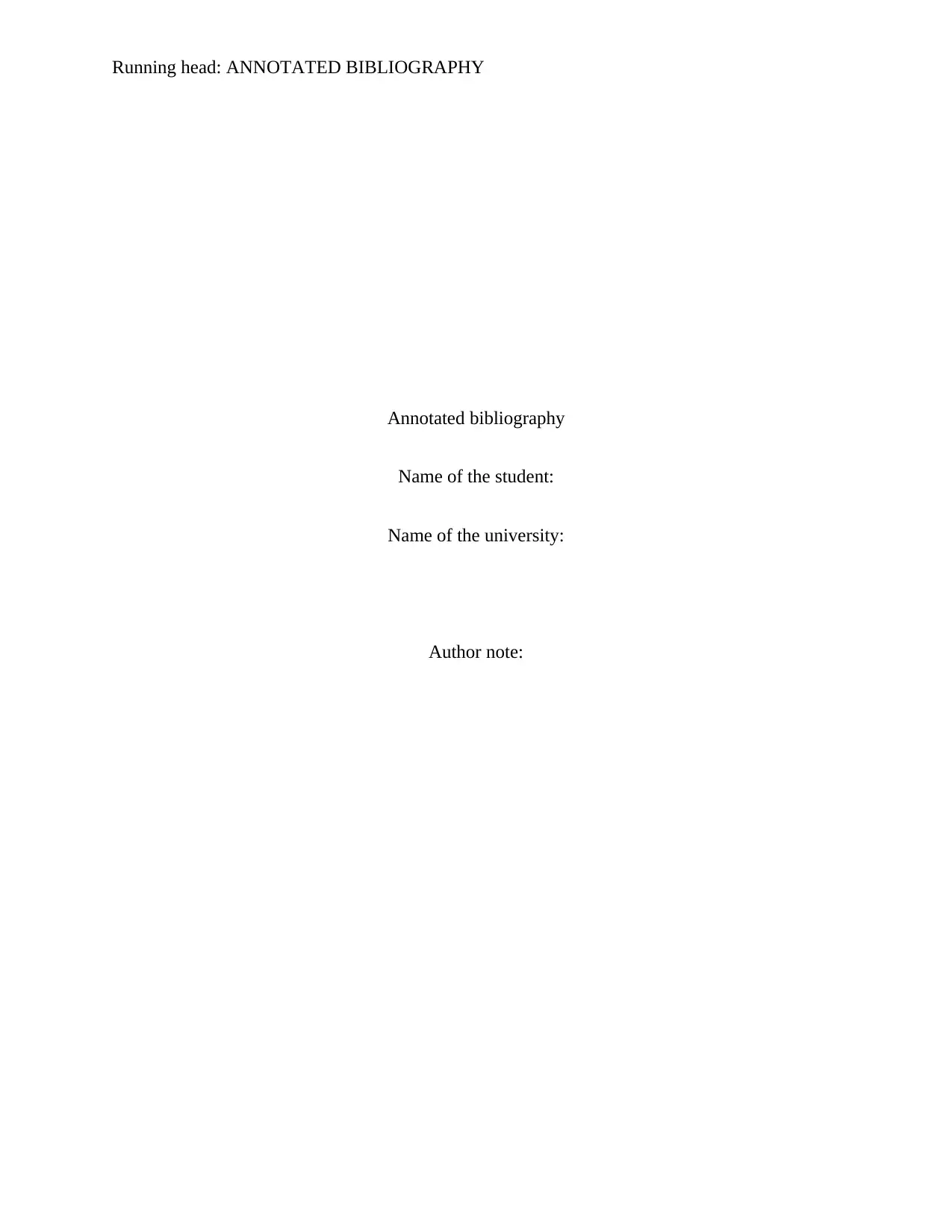
Running head: ANNOTATED BIBLIOGRAPHY
Annotated bibliography
Name of the student:
Name of the university:
Author note:
Annotated bibliography
Name of the student:
Name of the university:
Author note:
Paraphrase This Document
Need a fresh take? Get an instant paraphrase of this document with our AI Paraphraser
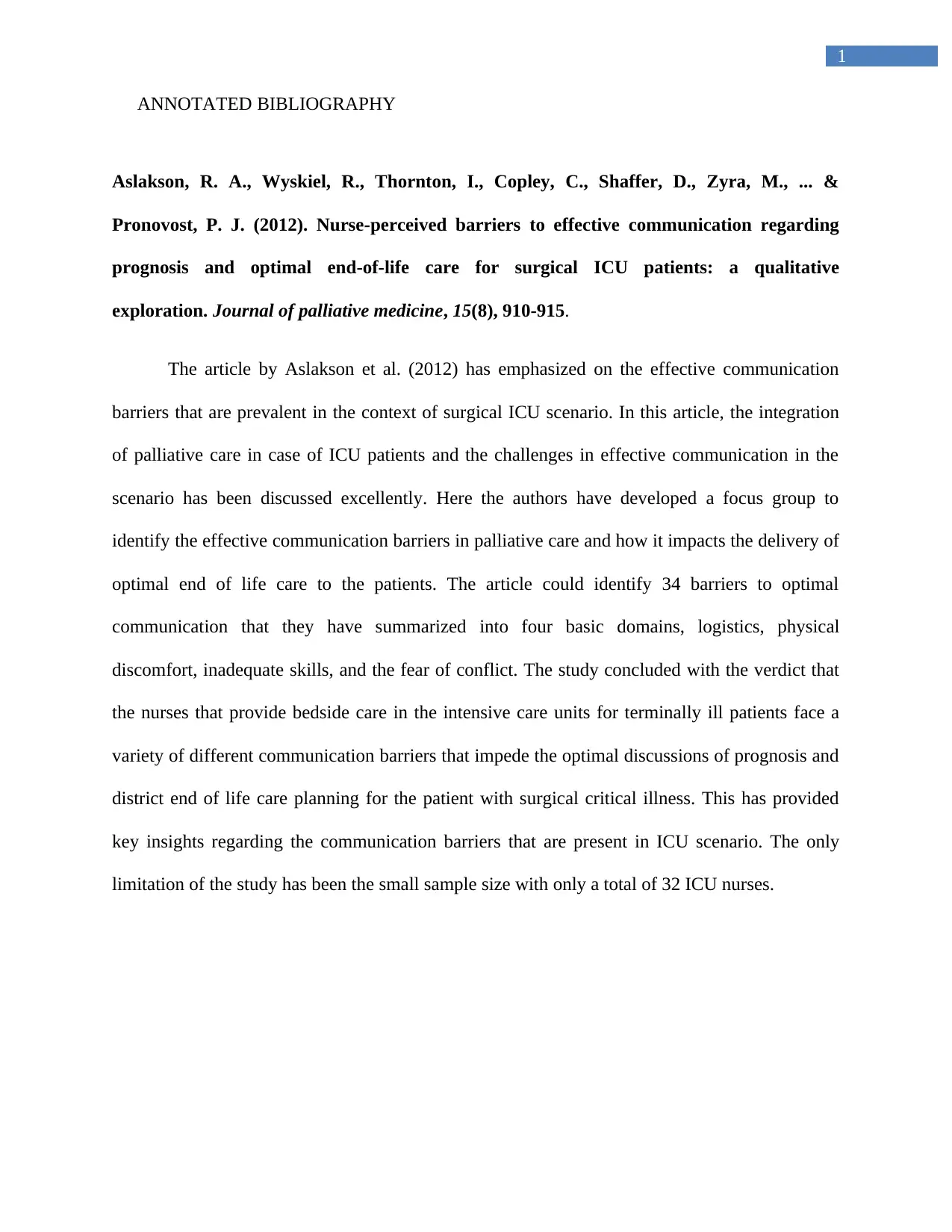
1
ANNOTATED BIBLIOGRAPHY
Aslakson, R. A., Wyskiel, R., Thornton, I., Copley, C., Shaffer, D., Zyra, M., ... &
Pronovost, P. J. (2012). Nurse-perceived barriers to effective communication regarding
prognosis and optimal end-of-life care for surgical ICU patients: a qualitative
exploration. Journal of palliative medicine, 15(8), 910-915.
The article by Aslakson et al. (2012) has emphasized on the effective communication
barriers that are prevalent in the context of surgical ICU scenario. In this article, the integration
of palliative care in case of ICU patients and the challenges in effective communication in the
scenario has been discussed excellently. Here the authors have developed a focus group to
identify the effective communication barriers in palliative care and how it impacts the delivery of
optimal end of life care to the patients. The article could identify 34 barriers to optimal
communication that they have summarized into four basic domains, logistics, physical
discomfort, inadequate skills, and the fear of conflict. The study concluded with the verdict that
the nurses that provide bedside care in the intensive care units for terminally ill patients face a
variety of different communication barriers that impede the optimal discussions of prognosis and
district end of life care planning for the patient with surgical critical illness. This has provided
key insights regarding the communication barriers that are present in ICU scenario. The only
limitation of the study has been the small sample size with only a total of 32 ICU nurses.
ANNOTATED BIBLIOGRAPHY
Aslakson, R. A., Wyskiel, R., Thornton, I., Copley, C., Shaffer, D., Zyra, M., ... &
Pronovost, P. J. (2012). Nurse-perceived barriers to effective communication regarding
prognosis and optimal end-of-life care for surgical ICU patients: a qualitative
exploration. Journal of palliative medicine, 15(8), 910-915.
The article by Aslakson et al. (2012) has emphasized on the effective communication
barriers that are prevalent in the context of surgical ICU scenario. In this article, the integration
of palliative care in case of ICU patients and the challenges in effective communication in the
scenario has been discussed excellently. Here the authors have developed a focus group to
identify the effective communication barriers in palliative care and how it impacts the delivery of
optimal end of life care to the patients. The article could identify 34 barriers to optimal
communication that they have summarized into four basic domains, logistics, physical
discomfort, inadequate skills, and the fear of conflict. The study concluded with the verdict that
the nurses that provide bedside care in the intensive care units for terminally ill patients face a
variety of different communication barriers that impede the optimal discussions of prognosis and
district end of life care planning for the patient with surgical critical illness. This has provided
key insights regarding the communication barriers that are present in ICU scenario. The only
limitation of the study has been the small sample size with only a total of 32 ICU nurses.
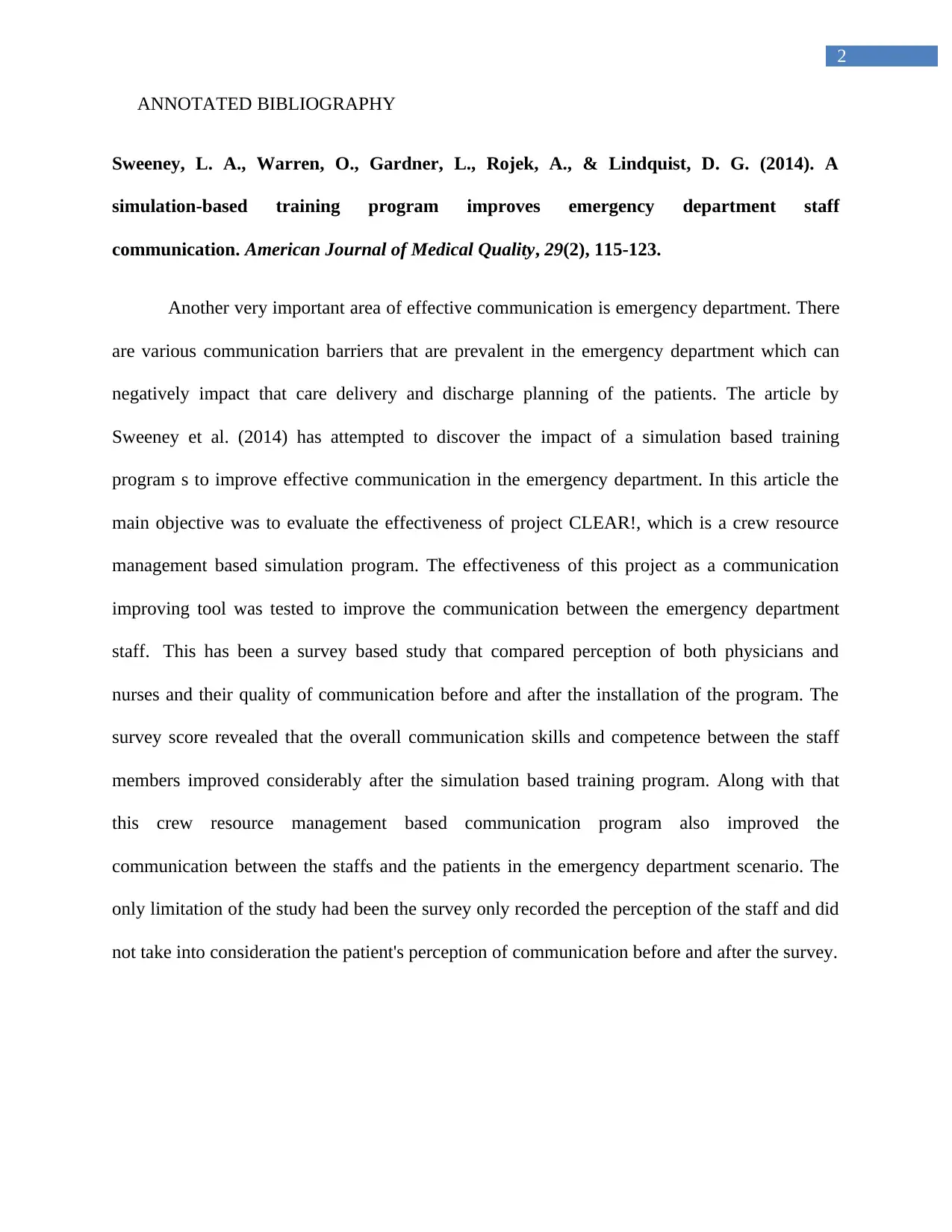
2
ANNOTATED BIBLIOGRAPHY
Sweeney, L. A., Warren, O., Gardner, L., Rojek, A., & Lindquist, D. G. (2014). A
simulation-based training program improves emergency department staff
communication. American Journal of Medical Quality, 29(2), 115-123.
Another very important area of effective communication is emergency department. There
are various communication barriers that are prevalent in the emergency department which can
negatively impact that care delivery and discharge planning of the patients. The article by
Sweeney et al. (2014) has attempted to discover the impact of a simulation based training
program s to improve effective communication in the emergency department. In this article the
main objective was to evaluate the effectiveness of project CLEAR!, which is a crew resource
management based simulation program. The effectiveness of this project as a communication
improving tool was tested to improve the communication between the emergency department
staff. This has been a survey based study that compared perception of both physicians and
nurses and their quality of communication before and after the installation of the program. The
survey score revealed that the overall communication skills and competence between the staff
members improved considerably after the simulation based training program. Along with that
this crew resource management based communication program also improved the
communication between the staffs and the patients in the emergency department scenario. The
only limitation of the study had been the survey only recorded the perception of the staff and did
not take into consideration the patient's perception of communication before and after the survey.
ANNOTATED BIBLIOGRAPHY
Sweeney, L. A., Warren, O., Gardner, L., Rojek, A., & Lindquist, D. G. (2014). A
simulation-based training program improves emergency department staff
communication. American Journal of Medical Quality, 29(2), 115-123.
Another very important area of effective communication is emergency department. There
are various communication barriers that are prevalent in the emergency department which can
negatively impact that care delivery and discharge planning of the patients. The article by
Sweeney et al. (2014) has attempted to discover the impact of a simulation based training
program s to improve effective communication in the emergency department. In this article the
main objective was to evaluate the effectiveness of project CLEAR!, which is a crew resource
management based simulation program. The effectiveness of this project as a communication
improving tool was tested to improve the communication between the emergency department
staff. This has been a survey based study that compared perception of both physicians and
nurses and their quality of communication before and after the installation of the program. The
survey score revealed that the overall communication skills and competence between the staff
members improved considerably after the simulation based training program. Along with that
this crew resource management based communication program also improved the
communication between the staffs and the patients in the emergency department scenario. The
only limitation of the study had been the survey only recorded the perception of the staff and did
not take into consideration the patient's perception of communication before and after the survey.
⊘ This is a preview!⊘
Do you want full access?
Subscribe today to unlock all pages.

Trusted by 1+ million students worldwide
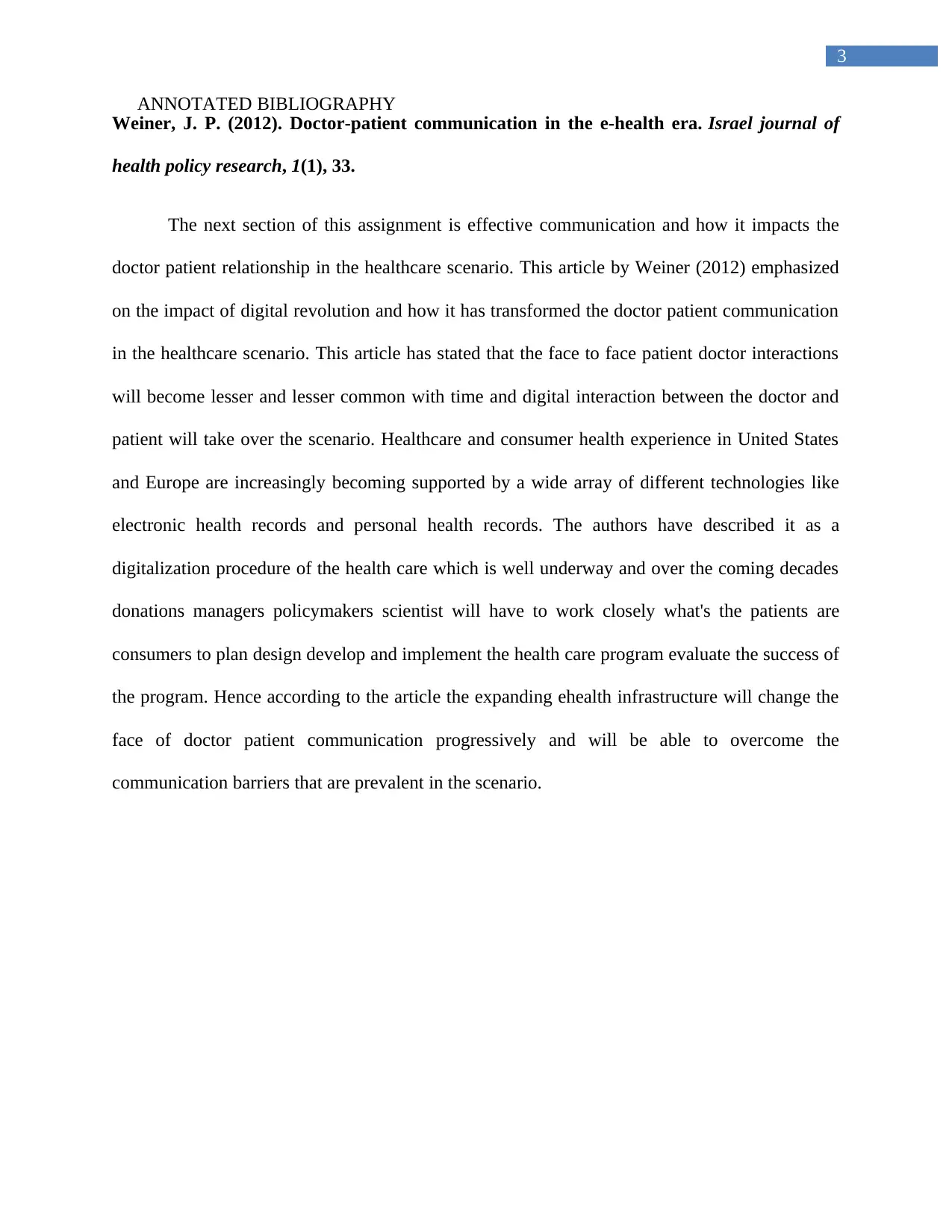
3
ANNOTATED BIBLIOGRAPHY
Weiner, J. P. (2012). Doctor-patient communication in the e-health era. Israel journal of
health policy research, 1(1), 33.
The next section of this assignment is effective communication and how it impacts the
doctor patient relationship in the healthcare scenario. This article by Weiner (2012) emphasized
on the impact of digital revolution and how it has transformed the doctor patient communication
in the healthcare scenario. This article has stated that the face to face patient doctor interactions
will become lesser and lesser common with time and digital interaction between the doctor and
patient will take over the scenario. Healthcare and consumer health experience in United States
and Europe are increasingly becoming supported by a wide array of different technologies like
electronic health records and personal health records. The authors have described it as a
digitalization procedure of the health care which is well underway and over the coming decades
donations managers policymakers scientist will have to work closely what's the patients are
consumers to plan design develop and implement the health care program evaluate the success of
the program. Hence according to the article the expanding ehealth infrastructure will change the
face of doctor patient communication progressively and will be able to overcome the
communication barriers that are prevalent in the scenario.
ANNOTATED BIBLIOGRAPHY
Weiner, J. P. (2012). Doctor-patient communication in the e-health era. Israel journal of
health policy research, 1(1), 33.
The next section of this assignment is effective communication and how it impacts the
doctor patient relationship in the healthcare scenario. This article by Weiner (2012) emphasized
on the impact of digital revolution and how it has transformed the doctor patient communication
in the healthcare scenario. This article has stated that the face to face patient doctor interactions
will become lesser and lesser common with time and digital interaction between the doctor and
patient will take over the scenario. Healthcare and consumer health experience in United States
and Europe are increasingly becoming supported by a wide array of different technologies like
electronic health records and personal health records. The authors have described it as a
digitalization procedure of the health care which is well underway and over the coming decades
donations managers policymakers scientist will have to work closely what's the patients are
consumers to plan design develop and implement the health care program evaluate the success of
the program. Hence according to the article the expanding ehealth infrastructure will change the
face of doctor patient communication progressively and will be able to overcome the
communication barriers that are prevalent in the scenario.
Paraphrase This Document
Need a fresh take? Get an instant paraphrase of this document with our AI Paraphraser
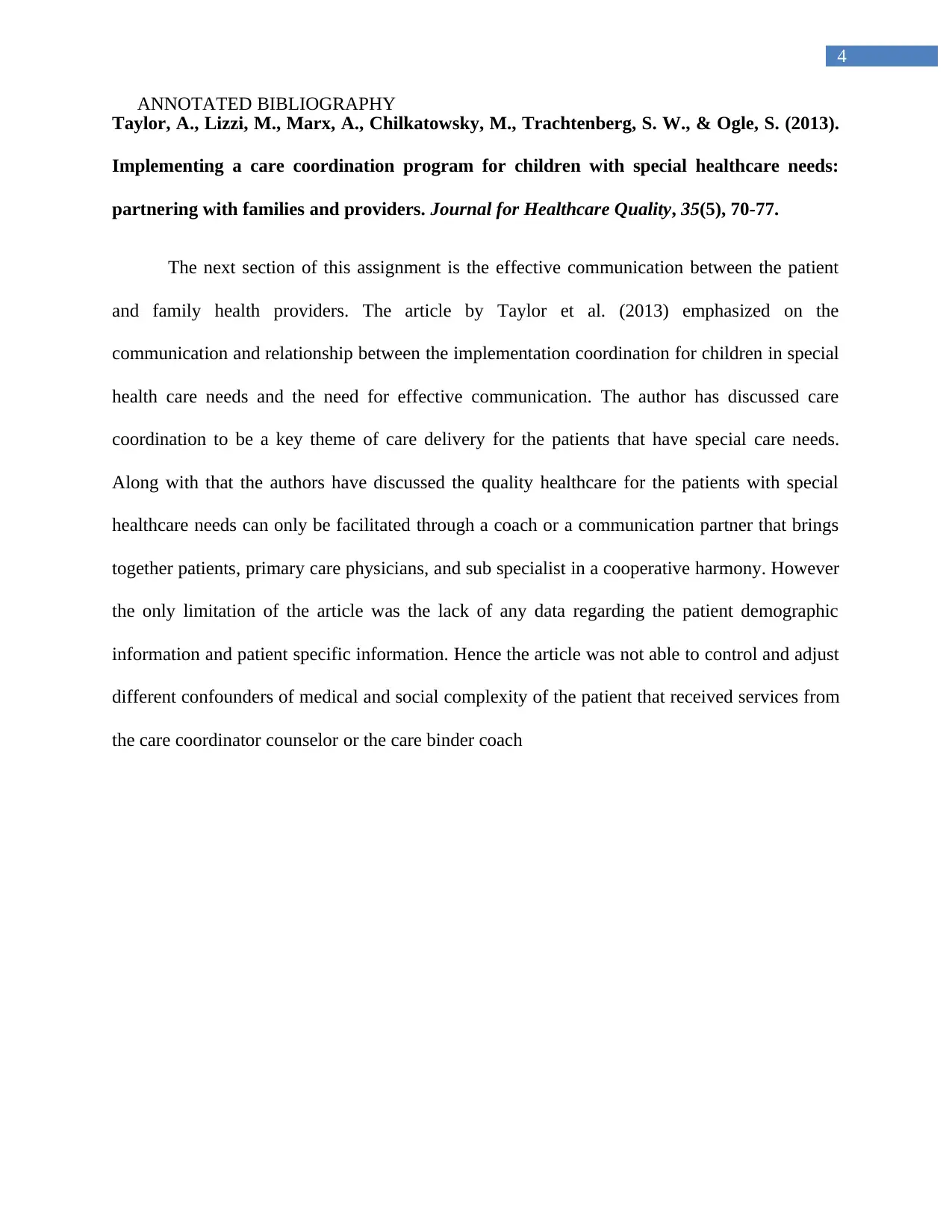
4
ANNOTATED BIBLIOGRAPHY
Taylor, A., Lizzi, M., Marx, A., Chilkatowsky, M., Trachtenberg, S. W., & Ogle, S. (2013).
Implementing a care coordination program for children with special healthcare needs:
partnering with families and providers. Journal for Healthcare Quality, 35(5), 70-77.
The next section of this assignment is the effective communication between the patient
and family health providers. The article by Taylor et al. (2013) emphasized on the
communication and relationship between the implementation coordination for children in special
health care needs and the need for effective communication. The author has discussed care
coordination to be a key theme of care delivery for the patients that have special care needs.
Along with that the authors have discussed the quality healthcare for the patients with special
healthcare needs can only be facilitated through a coach or a communication partner that brings
together patients, primary care physicians, and sub specialist in a cooperative harmony. However
the only limitation of the article was the lack of any data regarding the patient demographic
information and patient specific information. Hence the article was not able to control and adjust
different confounders of medical and social complexity of the patient that received services from
the care coordinator counselor or the care binder coach
ANNOTATED BIBLIOGRAPHY
Taylor, A., Lizzi, M., Marx, A., Chilkatowsky, M., Trachtenberg, S. W., & Ogle, S. (2013).
Implementing a care coordination program for children with special healthcare needs:
partnering with families and providers. Journal for Healthcare Quality, 35(5), 70-77.
The next section of this assignment is the effective communication between the patient
and family health providers. The article by Taylor et al. (2013) emphasized on the
communication and relationship between the implementation coordination for children in special
health care needs and the need for effective communication. The author has discussed care
coordination to be a key theme of care delivery for the patients that have special care needs.
Along with that the authors have discussed the quality healthcare for the patients with special
healthcare needs can only be facilitated through a coach or a communication partner that brings
together patients, primary care physicians, and sub specialist in a cooperative harmony. However
the only limitation of the article was the lack of any data regarding the patient demographic
information and patient specific information. Hence the article was not able to control and adjust
different confounders of medical and social complexity of the patient that received services from
the care coordinator counselor or the care binder coach
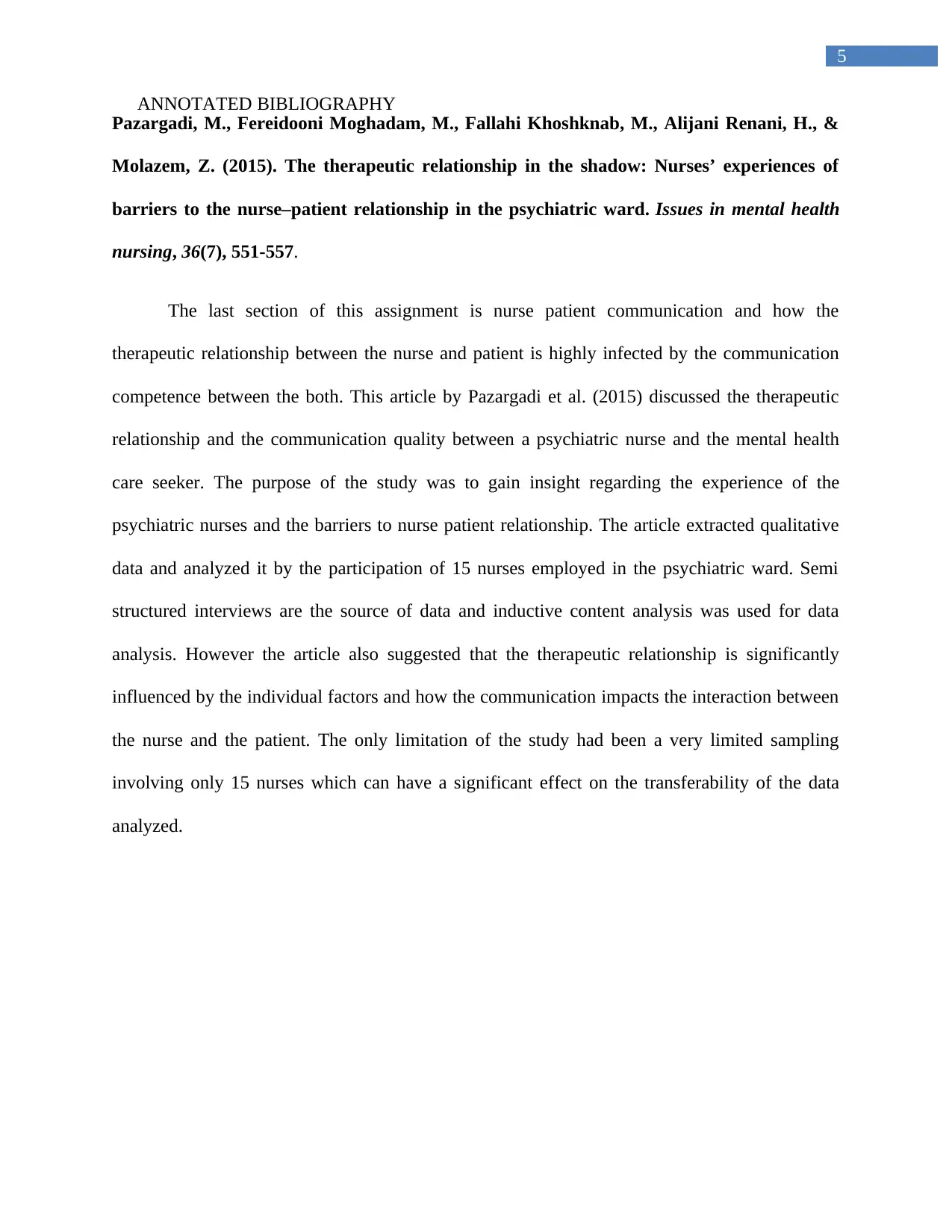
5
ANNOTATED BIBLIOGRAPHY
Pazargadi, M., Fereidooni Moghadam, M., Fallahi Khoshknab, M., Alijani Renani, H., &
Molazem, Z. (2015). The therapeutic relationship in the shadow: Nurses’ experiences of
barriers to the nurse–patient relationship in the psychiatric ward. Issues in mental health
nursing, 36(7), 551-557.
The last section of this assignment is nurse patient communication and how the
therapeutic relationship between the nurse and patient is highly infected by the communication
competence between the both. This article by Pazargadi et al. (2015) discussed the therapeutic
relationship and the communication quality between a psychiatric nurse and the mental health
care seeker. The purpose of the study was to gain insight regarding the experience of the
psychiatric nurses and the barriers to nurse patient relationship. The article extracted qualitative
data and analyzed it by the participation of 15 nurses employed in the psychiatric ward. Semi
structured interviews are the source of data and inductive content analysis was used for data
analysis. However the article also suggested that the therapeutic relationship is significantly
influenced by the individual factors and how the communication impacts the interaction between
the nurse and the patient. The only limitation of the study had been a very limited sampling
involving only 15 nurses which can have a significant effect on the transferability of the data
analyzed.
ANNOTATED BIBLIOGRAPHY
Pazargadi, M., Fereidooni Moghadam, M., Fallahi Khoshknab, M., Alijani Renani, H., &
Molazem, Z. (2015). The therapeutic relationship in the shadow: Nurses’ experiences of
barriers to the nurse–patient relationship in the psychiatric ward. Issues in mental health
nursing, 36(7), 551-557.
The last section of this assignment is nurse patient communication and how the
therapeutic relationship between the nurse and patient is highly infected by the communication
competence between the both. This article by Pazargadi et al. (2015) discussed the therapeutic
relationship and the communication quality between a psychiatric nurse and the mental health
care seeker. The purpose of the study was to gain insight regarding the experience of the
psychiatric nurses and the barriers to nurse patient relationship. The article extracted qualitative
data and analyzed it by the participation of 15 nurses employed in the psychiatric ward. Semi
structured interviews are the source of data and inductive content analysis was used for data
analysis. However the article also suggested that the therapeutic relationship is significantly
influenced by the individual factors and how the communication impacts the interaction between
the nurse and the patient. The only limitation of the study had been a very limited sampling
involving only 15 nurses which can have a significant effect on the transferability of the data
analyzed.
⊘ This is a preview!⊘
Do you want full access?
Subscribe today to unlock all pages.

Trusted by 1+ million students worldwide
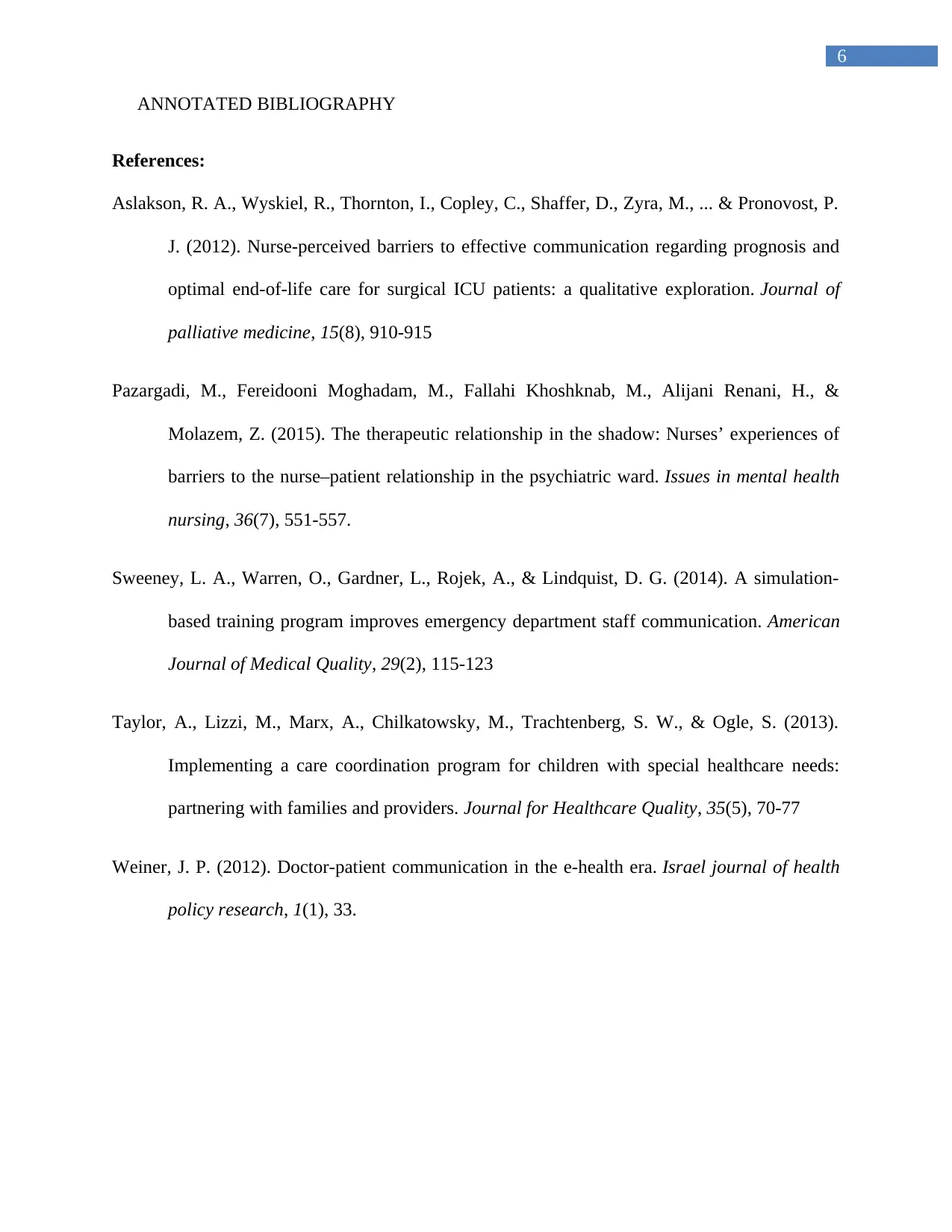
6
ANNOTATED BIBLIOGRAPHY
References:
Aslakson, R. A., Wyskiel, R., Thornton, I., Copley, C., Shaffer, D., Zyra, M., ... & Pronovost, P.
J. (2012). Nurse-perceived barriers to effective communication regarding prognosis and
optimal end-of-life care for surgical ICU patients: a qualitative exploration. Journal of
palliative medicine, 15(8), 910-915
Pazargadi, M., Fereidooni Moghadam, M., Fallahi Khoshknab, M., Alijani Renani, H., &
Molazem, Z. (2015). The therapeutic relationship in the shadow: Nurses’ experiences of
barriers to the nurse–patient relationship in the psychiatric ward. Issues in mental health
nursing, 36(7), 551-557.
Sweeney, L. A., Warren, O., Gardner, L., Rojek, A., & Lindquist, D. G. (2014). A simulation-
based training program improves emergency department staff communication. American
Journal of Medical Quality, 29(2), 115-123
Taylor, A., Lizzi, M., Marx, A., Chilkatowsky, M., Trachtenberg, S. W., & Ogle, S. (2013).
Implementing a care coordination program for children with special healthcare needs:
partnering with families and providers. Journal for Healthcare Quality, 35(5), 70-77
Weiner, J. P. (2012). Doctor-patient communication in the e-health era. Israel journal of health
policy research, 1(1), 33.
ANNOTATED BIBLIOGRAPHY
References:
Aslakson, R. A., Wyskiel, R., Thornton, I., Copley, C., Shaffer, D., Zyra, M., ... & Pronovost, P.
J. (2012). Nurse-perceived barriers to effective communication regarding prognosis and
optimal end-of-life care for surgical ICU patients: a qualitative exploration. Journal of
palliative medicine, 15(8), 910-915
Pazargadi, M., Fereidooni Moghadam, M., Fallahi Khoshknab, M., Alijani Renani, H., &
Molazem, Z. (2015). The therapeutic relationship in the shadow: Nurses’ experiences of
barriers to the nurse–patient relationship in the psychiatric ward. Issues in mental health
nursing, 36(7), 551-557.
Sweeney, L. A., Warren, O., Gardner, L., Rojek, A., & Lindquist, D. G. (2014). A simulation-
based training program improves emergency department staff communication. American
Journal of Medical Quality, 29(2), 115-123
Taylor, A., Lizzi, M., Marx, A., Chilkatowsky, M., Trachtenberg, S. W., & Ogle, S. (2013).
Implementing a care coordination program for children with special healthcare needs:
partnering with families and providers. Journal for Healthcare Quality, 35(5), 70-77
Weiner, J. P. (2012). Doctor-patient communication in the e-health era. Israel journal of health
policy research, 1(1), 33.
1 out of 7
Your All-in-One AI-Powered Toolkit for Academic Success.
+13062052269
info@desklib.com
Available 24*7 on WhatsApp / Email
![[object Object]](/_next/static/media/star-bottom.7253800d.svg)
Unlock your academic potential
Copyright © 2020–2025 A2Z Services. All Rights Reserved. Developed and managed by ZUCOL.


